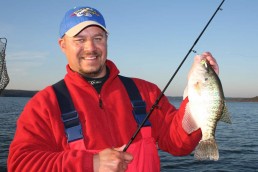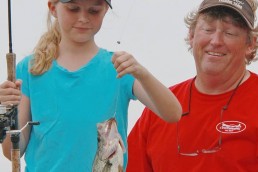February’s Crappies: A Prelude to Spring
SHARE THIS POST
Tennessee has two indigenous crappie species: black (Pomoxis nigro-maculatus) and white (Pomoxis annularis). The blacknose crappie is a black crappie with a racing stripe down its forehead. It has been stocked successfully in a number of Tennessee lakes. The black nose of the black crappie occurs naturally, but the species is cultivated in large numbers in hatcheries for studies because it has the “natural” black marker for easy identification.
Because there are differences between black and white crappies, it’s good to have an idea how they differ. So, if the lake you are fishing has more of one of the aforementioned crappies than the other, you can change your approach to maximize your catch rate.
Black crappies feed on aquatic insects, other invertebrates and baitfish. The white crappies prefer a diet of baitfish, such as shad. The black crappies prefer deep, clear, slow water, vegetation and are more accepting of acidic water (lower pH). They bed in tight colonies, usually over gravel, and a couple of weeks earlier than the white crappies in Tennessee.
White crappies prefer murky, shallow water with shoreline structure such as bushes, downed trees and stumps, and tolerate alkaline water (higher pH). White crappies will choose mud and sand bottoms with dingy water in coves and creeks for their spawning grounds. Like black crappies, the white bed in tight colonies, but with little differentiation between their nests on the soft bottom.
Look at the arrangements of black spots rather than color to distinguish between the two. The white crappies have organized black spots in vertical bands, making a recognizable pattern. The black crappies’ spots have no pattern, although sometimes these speckles suggest horizontal bands.
Crappies’ movements
In early February, crappies won’t expend any more energy than necessary due to their reduced metabolic rate. They aren’t going to be roaming around a tributary lake in winter—they are going to be on the trees anywhere between 15 and 25 feet deep. The most productive places to fish are in coves where trees were left standing in water 50 feet deep.
Some crappies migrate to the upper ends of tributary reservoirs where there is a little current. There may be some current in the larger feeder creeks too; crappies prefer areas where a little current carries food along the channel.
Harold Morgan of Nashville, and former crappie guide, says, “Crappies, like bass, hold on steep banks and ledges in winter. They will move into shallower water on sunny days, between 7 and 10 feet. They move up to get warm. This means you may find fish in the backs of deep coves on sunny days. They won’t stay there at night, but you’ll find them from about mid-morning until mid-afternoon.
“Try fishing 10 feet deep on the flats in the deep coves. They won’t be on cover because it’s shady and crappies (members of the sunfish family) are looking for warm sunshine. The sun may raise the water temperature by as much as 10 degrees. Minnows should be more active in the coves too, that’s another reason to fish there.”
Are you enjoying this post?
You can be among the first to get the latest info on where to go, what to use and how to use it!
Pre-spawn staging
By late February, lake waters usually warm up enough to initiate the fish searching for baitfish and entering shallow waters. But with a return of cold weather, they retreat to deeper water. The movements in and out of shallow areas can happen quickly—you can be catching plenty of fish one minute and then none the next.
When the water surface temperature is in the upper 40s to 50s, crappies migrate to shallow water in stages. They stage between deep water and their spawning area in a stair-step progression as the water temperature and daylight hours increase over a two- to three-week period. The staging areas are bump-ups, ridges, ledges and other irregularities in the bottom that lead to shallow water. Creek channels are favored routes because they usually have flats associated with them as suitable spawning sites. Crappies return to the same sites year after year if the habitat is still suitable for spawning.
Black and white crappies wait for weather and water temperatures to be just right before committing to spawn in the shallows. Spawning grounds are near creek mouths, in coves, and bays, but some spawn on humps and flats along the main channel of flatland and hill-land lakes.
Techniques
To catch wintertime crappies you need to use light line. Six-pound-test is good, but 4-pound-test would be better. Use a lightweight sinker, a number 7 split shot or maybe smaller.
A small minnow is your best bait because crappies are dainty eaters this time of year. If you want to use jigs, try 1/32- 1/16- or 1/8-ounce lead heads. It takes a while for the 1/32- and 1/16-ounce jig to sink 15 to 25 feet, but they are the best of the three weights. Four-pound-test line lets the lighter jigs sink faster.
Wintertime crappies are light hitters and you probably won’t feel them. When you see your line barely move, set the hook. Once a crappie hits your minnow or jig and you miss the hook-set, it won’t give you another chance. You’ll have to entice another one to bite.
A little wind helps move your bait, but if the wind is calm, use your finger to barely “tic” your line to give your bait just a little motion. These crappies won’t move far to pick up your bait, making your bait placement important.
Remember, the best thing about February is that the crappie springtime spawn is not far away.
MWO
SHARE THIS POST
Did you enjoy this post?
You can be among the first to get the latest info on where to go, what to use and how to use it!
Vernon Summerlin
For more than 30 years, Vernon Summerlin has produced outdoor articles and books that can be found on Amazon; most recently How to Analyze a Bass Hole: Think and Catch’em! He is the recipient of more than 40 awards for magazine and newspaper articles, TV, radio, photography and books.



